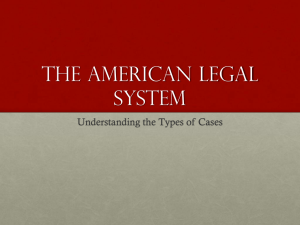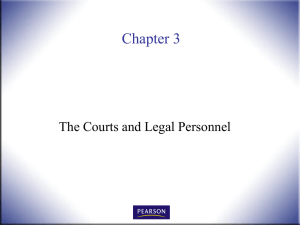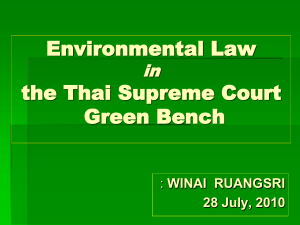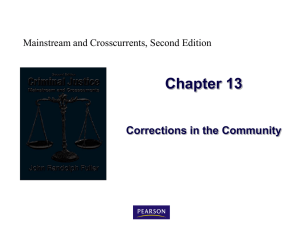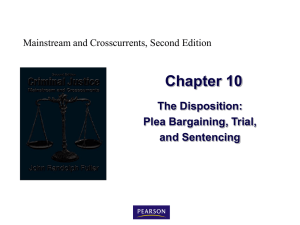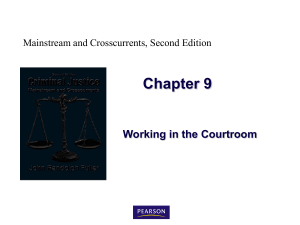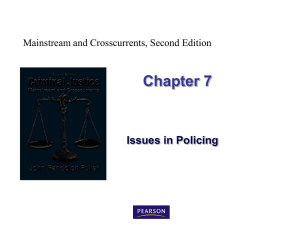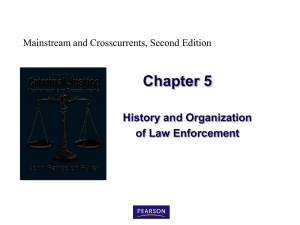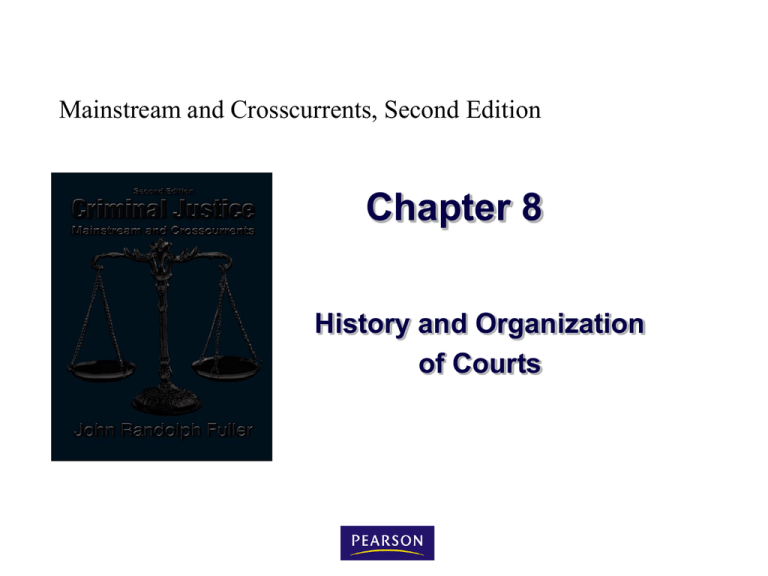
Mainstream and Crosscurrents, Second Edition
Chapter 8
History and Organization
of Courts
Concerns of the court
The US criminal court system is an
adversarial process.
Outsiders have difficulty understanding what
is happening in the court.
Criminal Justice: Mainstream and Crosscurrents, 2/e
John Randolph Fuller
2
© 2010 Pearson Higher Education,
Upper Saddle River, NJ 07458. • All Rights Reserved.
CrossCurrents
Notes of a truTV junkie
Do you watch television court and crime
shows? Do you believe they are realistic?
Why or why not?
Are reality court and crime television
shows educational or are they pure
entertainment?
Criminal Justice: Mainstream and Crosscurrents, 2/e
John Randolph Fuller
3
© 2010 Pearson Higher Education,
Upper Saddle River, NJ 07458. • All Rights Reserved.
Courts in history
The blood feud
Courts in England
Trial by compurgation
Trial by ordeal
Trial by battle
Criminal Justice: Mainstream and Crosscurrents, 2/e
John Randolph Fuller
4
© 2010 Pearson Higher Education,
Upper Saddle River, NJ 07458. • All Rights Reserved.
Courts in history
The blood feud
The blood feud is based on
vengeance.
In some societies, a payment
could be made to the victim’s
family in lieu of violence.
Criminal Justice: Mainstream and Crosscurrents, 2/e
John Randolph Fuller
5
© 2010 Pearson Higher Education,
Upper Saddle River, NJ 07458. • All Rights Reserved.
Courts in history
Courts in England
The court did more than resolve conflicts
and were convened for special occasions.
The lines between civil and criminal cases
were not established.
Provided revenues for the king and
nobles.
Crimes were redefined as offenses against
the state.
Criminal Justice: Mainstream and Crosscurrents, 2/e
John Randolph Fuller
6
© 2010 Pearson Higher Education,
Upper Saddle River, NJ 07458. • All Rights Reserved.
Courts in history
Trial by compurgation
Compurgation—The practice of
taking an oath of truth
The value of the oath was tied to the
value of the oath-taker’s life.
Criminal Justice: Mainstream and Crosscurrents, 2/e
John Randolph Fuller
7
© 2010 Pearson Higher Education,
Upper Saddle River, NJ 07458. • All Rights Reserved.
Courts in history
Trial by ordeal
Trial by cold water
Trial by hot water
Trial by hot iron or fire
Criminal Justice: Mainstream and Crosscurrents, 2/e
John Randolph Fuller
8
© 2010 Pearson Higher Education,
Upper Saddle River, NJ 07458. • All Rights Reserved.
Courts in history
Trial by ordeal
Depended on divine
intervention to demonstrate
the innocence of the accused.
Criminal Justice: Mainstream and Crosscurrents, 2/e
John Randolph Fuller
9
© 2010 Pearson Higher Education,
Upper Saddle River, NJ 07458. • All Rights Reserved.
Courts in history
Trial by battle
Originally used by knights to solve
disputes.
Litigants could select someone else
to fight for them.
Criminal Justice: Mainstream and Crosscurrents, 2/e
John Randolph Fuller
10
© 2010 Pearson Higher Education,
Upper Saddle River, NJ 07458. • All Rights Reserved.
Development of the Jury
The inquest can be considered to be the
first type of jury.
Criminal Justice: Mainstream and Crosscurrents, 2/e
John Randolph Fuller
11
© 2010 Pearson Higher Education,
Upper Saddle River, NJ 07458. • All Rights Reserved.
Development of the Jury
Grand jury
Jury trial
Magna Carta
Court of the Star Chamber
Criminal Justice: Mainstream and Crosscurrents, 2/e
John Randolph Fuller
12
© 2010 Pearson Higher Education,
Upper Saddle River, NJ 07458. • All Rights Reserved.
Development of the jury
Grand jury
The Assize of Clarendon established
the beginnings of the grand jury system.
Modern grand juries are primarily a check
on the prosecutor.
Determines whether the evidence is
strong enough to charge the accused.
Criminal Justice: Mainstream and Crosscurrents, 2/e
John Randolph Fuller
13
© 2010 Pearson Higher Education,
Upper Saddle River, NJ 07458. • All Rights Reserved.
Development of the jury
Jury trial
The church stopped supporting trial by
ordeal.
Originally, the jury and the grand jury
comprised the same members.
Evolved into a check on the state’s power
to prosecute citizens.
Criminal Justice: Mainstream and Crosscurrents, 2/e
John Randolph Fuller
14
© 2010 Pearson Higher Education,
Upper Saddle River, NJ 07458. • All Rights Reserved.
Development of the jury
Magna Carta
Signed by King John in 1215.
Limited the king’s power and recognized
nobles’ rights.
Criminal Justice: Mainstream and Crosscurrents, 2/e
John Randolph Fuller
15
© 2010 Pearson Higher Education,
Upper Saddle River, NJ 07458. • All Rights Reserved.
Development of the jury
Court of the Star Chamber
Established to deal with offenses such as
riots, unlawful assembly, perjury, criminal
libel, and conspiracy.
Noted for its abuses
Abolished in 1641
Criminal Justice: Mainstream and Crosscurrents, 2/e
John Randolph Fuller
16
© 2010 Pearson Higher Education,
Upper Saddle River, NJ 07458. • All Rights Reserved.
Courts in Colonial America
Colonial courts developed in response
to the local concerns of each colony.
Criminal Justice: Mainstream and Crosscurrents, 2/e
John Randolph Fuller
17
© 2010 Pearson Higher Education,
Upper Saddle River, NJ 07458. • All Rights Reserved.
Courts in Colonial America
Slavery and the law
Our heritage of due process
Criminal Justice: Mainstream and Crosscurrents, 2/e
John Randolph Fuller
18
© 2010 Pearson Higher Education,
Upper Saddle River, NJ 07458. • All Rights Reserved.
Courts in Colonial America
Slavery and the law
The early adoption of slavery caused
problems for the justice system.
An alternative system of laws was
created to control slaves.
Criminal Justice: Mainstream and Crosscurrents, 2/e
John Randolph Fuller
19
© 2010 Pearson Higher Education,
Upper Saddle River, NJ 07458. • All Rights Reserved.
Courts in colonial America
Our heritage of due process
One of the enduring consequences of
independence from England is the
documents that were created to specify the
relationship between the people and the
state.
The Constitution
The Bill of Rights
Criminal Justice: Mainstream and Crosscurrents, 2/e
John Randolph Fuller
20
© 2010 Pearson Higher Education,
Upper Saddle River, NJ 07458. • All Rights Reserved.
Changing nature of the court
Marbury v. Madison
McCulloch v. Maryland
Supremacy Clause
Reconstruction and expansion of federal
authority
Business, unions, and civil liberties
Plessy v. Ferguson
The Warren Court
Criminal Justice: Mainstream and Crosscurrents, 2/e
John Randolph Fuller
21
© 2010 Pearson Higher Education,
Upper Saddle River, NJ 07458. • All Rights Reserved.
Changing nature of the court
Marbury v. Madison
Established the judiciary as equal
to the executive and legislative
branches of government.
Criminal Justice: Mainstream and Crosscurrents, 2/e
John Randolph Fuller
22
© 2010 Pearson Higher Education,
Upper Saddle River, NJ 07458. • All Rights Reserved.
Changing nature of the court
McCulloch v. Maryland
Established that the court could
find that the Constitution included
implied powers that could be
deduced from its nature and
language.
Criminal Justice: Mainstream and Crosscurrents, 2/e
John Randolph Fuller
23
© 2010 Pearson Higher Education,
Upper Saddle River, NJ 07458. • All Rights Reserved.
Changing nature of the court
Supremacy Clause
The US Supreme Court
established its power as the "final
word" on all cases and became "the
court of last resort."
Criminal Justice: Mainstream and Crosscurrents, 2/e
John Randolph Fuller
24
© 2010 Pearson Higher Education,
Upper Saddle River, NJ 07458. • All Rights Reserved.
Changing nature of the court
Reconstruction and the expansion of federal
authority
The social and political issues of
various places and decades
influenced how courts ruled.
Criminal Justice: Mainstream and Crosscurrents, 2/e
John Randolph Fuller
25
© 2010 Pearson Higher Education,
Upper Saddle River, NJ 07458. • All Rights Reserved.
Changing nature of the court
Business, unions, & civil liberties
The courts used the Fourteenth
Amendment to protect the interests
of business.
Criminal Justice: Mainstream and Crosscurrents, 2/e
John Randolph Fuller
26
© 2010 Pearson Higher Education,
Upper Saddle River, NJ 07458. • All Rights Reserved.
Changing nature of the court
Plessy v. Ferguson
The 1896 Court mandated that
"separate but equal" was reasonable.
Criminal Justice: Mainstream and Crosscurrents, 2/e
John Randolph Fuller
27
© 2010 Pearson Higher Education,
Upper Saddle River, NJ 07458. • All Rights Reserved.
Changing nature of the court
The Warren Court
Expanded the rights of due process
and earned a reputation for
championing the causes of society's
peoples.
Criminal Justice: Mainstream and Crosscurrents, 2/e
John Randolph Fuller
28
© 2010 Pearson Higher Education,
Upper Saddle River, NJ 07458. • All Rights Reserved.
Organization of the courts
The difference between civil
courts and criminal courts lies in
the types of law they deal with …
Criminal Justice: Mainstream and Crosscurrents, 2/e
John Randolph Fuller
29
© 2010 Pearson Higher Education,
Upper Saddle River, NJ 07458. • All Rights Reserved.
Organization of the courts
Criminal law concerns the major
violations against society and
violations are punishable by prison.
Civil law governs private issues.
Violations are not punishable by
prison.
Criminal Justice: Mainstream and Crosscurrents, 2/e
John Randolph Fuller
30
© 2010 Pearson Higher Education,
Upper Saddle River, NJ 07458. • All Rights Reserved.
Organization of the courts
Nature of jurisdiction
Structure of the federal courts
State courts
Criminal Justice: Mainstream and Crosscurrents, 2/e
John Randolph Fuller
31
© 2010 Pearson Higher Education,
Upper Saddle River, NJ 07458. • All Rights Reserved.
Organization of the courts
Nature of jurisdiction
Subject matter jurisdiction
Geographic jurisdiction
Hierarchical jurisdiction
Criminal Justice: Mainstream and Crosscurrents, 2/e
John Randolph Fuller
32
© 2010 Pearson Higher Education,
Upper Saddle River, NJ 07458. • All Rights Reserved.
Nature of jurisdiction
Subject matter jurisdiction
The nature of the case can
determine which court will have
jurisdiction.
Criminal Justice: Mainstream and Crosscurrents, 2/e
John Randolph Fuller
33
© 2010 Pearson Higher Education,
Upper Saddle River, NJ 07458. • All Rights Reserved.
Nature of jurisdiction
Geographic jurisdiction
The political boundaries of cities,
counties, and states can determine
the geographic jurisdiction of a court.
Criminal Justice: Mainstream and Crosscurrents, 2/e
John Randolph Fuller
34
© 2010 Pearson Higher Education,
Upper Saddle River, NJ 07458. • All Rights Reserved.
Nature of jurisdiction
Hierarchical jurisdiction
Trial courts hear the facts of the
case.
Appellate courts review the
work of the trial court judge.
Criminal Justice: Mainstream and Crosscurrents, 2/e
John Randolph Fuller
35
© 2010 Pearson Higher Education,
Upper Saddle River, NJ 07458. • All Rights Reserved.
Organization of the courts
Structure of the federal courts
Four levels of federal courts...
Magistrate courts
US district courts
US circuit courts of appeal
US Supreme Court
There are also specialized federal courts.
Criminal Justice: Mainstream and Crosscurrents, 2/e
John Randolph Fuller
36
© 2010 Pearson Higher Education,
Upper Saddle River, NJ 07458. • All Rights Reserved.
Federal court jurisdictions
Criminal Justice: Mainstream and Crosscurrents, 2/e
John Randolph Fuller
37
© 2010 Pearson Higher Education,
Upper Saddle River, NJ 07458. • All Rights Reserved.
Organization of the courts
Structure of the federal courts
Federal courts hear the following types
of cases …
Suits involving the government
Suits between two more more states
Suits involving public ministers
Suits involving laws passed by Congress,
treaties, and maritime laws
Criminal Justice: Mainstream and Crosscurrents, 2/e
John Randolph Fuller
38
© 2010 Pearson Higher Education,
Upper Saddle River, NJ 07458. • All Rights Reserved.
Structure of the federal courts
US magistrate courts
The lowest level of the federal court
system, magistrate courts operate as
courts of limited jurisdiction.
Criminal Justice: Mainstream and Crosscurrents, 2/e
John Randolph Fuller
39
© 2010 Pearson Higher Education,
Upper Saddle River, NJ 07458. • All Rights Reserved.
Structure of the federal courts
US district courts
Try felony cases involving federal laws
and civil cases in which the amount of
money in controversy exceeds
$75,000.
Criminal Justice: Mainstream and Crosscurrents, 2/e
John Randolph Fuller
40
© 2010 Pearson Higher Education,
Upper Saddle River, NJ 07458. • All Rights Reserved.
Structure of the federal courts
US district courts
Handle bankruptcy cases, felony cases
involving federal laws and civil cases in
which the amount of money in
controversy exceeds $75,000.
Criminal Justice: Mainstream and Crosscurrents, 2/e
John Randolph Fuller
41
© 2010 Pearson Higher Education,
Upper Saddle River, NJ 07458. • All Rights Reserved.
Structure of the federal courts
US courts of appeals
Serve as intermediate courts of
appeals and dispose of many before
they reach the Supreme Court.
Criminal Justice: Mainstream and Crosscurrents, 2/e
John Randolph Fuller
42
© 2010 Pearson Higher Education,
Upper Saddle River, NJ 07458. • All Rights Reserved.
Structure of the federal courts
US Supreme Court
The court of last resort hears only
about 80 cases a year, all of which
must involve a "substantial federal
question."
Criminal Justice: Mainstream and Crosscurrents, 2/e
John Randolph Fuller
43
© 2010 Pearson Higher Education,
Upper Saddle River, NJ 07458. • All Rights Reserved.
Structure of the federal courts
Specialized federal courts
Handle primarily civil cases, monetary
claims against the federal government,
and certain criminal cases.
Criminal Justice: Mainstream and Crosscurrents, 2/e
John Randolph Fuller
44
© 2010 Pearson Higher Education,
Upper Saddle River, NJ 07458. • All Rights Reserved.
Organization of the courts
State courts
Juvenile courts
State trial courts
State intermediate courts of appeals
State supreme courts
Criminal Justice: Mainstream and Crosscurrents, 2/e
John Randolph Fuller
45
© 2010 Pearson Higher Education,
Upper Saddle River, NJ 07458. • All Rights Reserved.
CrossCurrents Organization of the Courts
California rules
The nation’s courts follow California, at least
according to a recent study by two legal experts.
California has 1260 followed decisions.
Study: One reason is the size and diversity of its
population, culture, and economy.
Criminal Justice: Mainstream and Crosscurrents, 2/e
John Randolph Fuller
46
© 2010 Pearson Higher Education,
Upper Saddle River, NJ 07458. • All Rights Reserved.
State courts
Juvenile courts
Unlike adult courts, juvenile courts
follow civil law because the primary
goal of juvenile courts is rehabilitation
not punishment.
Criminal Justice: Mainstream and Crosscurrents, 2/e
John Randolph Fuller
47
© 2010 Pearson Higher Education,
Upper Saddle River, NJ 07458. • All Rights Reserved.
State courts
State trial courts
Lower courts handle mostly traffic
cases, misdemeanors, small claims,
and the preliminary stages of felony
cases.
Major trial courts hear most of the
serious street-crime cases.
Criminal Justice: Mainstream and Crosscurrents, 2/e
John Randolph Fuller
48
© 2010 Pearson Higher Education,
Upper Saddle River, NJ 07458. • All Rights Reserved.
State courts
State intermediate courts of appeals
Usually the decision at the
intermediate court of appeal level will
be the final decision.
Criminal Justice: Mainstream and Crosscurrents, 2/e
John Randolph Fuller
49
© 2010 Pearson Higher Education,
Upper Saddle River, NJ 07458. • All Rights Reserved.
State courts
State supreme courts
These courts are the court of last resort
for all but a very few cases that bear
issues of constitutional or federal law.
Criminal Justice: Mainstream and Crosscurrents, 2/e
John Randolph Fuller
50
© 2010 Pearson Higher Education,
Upper Saddle River, NJ 07458. • All Rights Reserved.
State courts
Local courts and community courts
Each state has its own jurisdictional pattern to allow
municipalities, counties, and neighborhoods to
structure their legal systems in a way that best
responds to citizens.
Drug courts
Conflict resolution programs
Family courts
Magistrate courts
Criminal Justice: Mainstream and Crosscurrents, 2/e
John Randolph Fuller
51
© 2010 Pearson Higher Education,
Upper Saddle River, NJ 07458. • All Rights Reserved.
State courts
Drug courts
Drug courts allow the criminal justice
system to accomplish several goals.
Offenders can be treated more
consistently.
Drug-court personnel are more aware
of community treatment options.
It is less expensive and more efficient.
Criminal Justice: Mainstream and Crosscurrents, 2/e
John Randolph Fuller
52
© 2010 Pearson Higher Education,
Upper Saddle River, NJ 07458. • All Rights Reserved.
State courts
Conflict resolution programs
Many low-level offenses can be more
efficiently dealt with by allowing offenders
and victims to work out their disputes
between themselves.
Criminal Justice: Mainstream and Crosscurrents, 2/e
John Randolph Fuller
53
© 2010 Pearson Higher Education,
Upper Saddle River, NJ 07458. • All Rights Reserved.
State courts
Family courts
Family courts may be incorporated into the
juvenile court.
Court personnel can be more specialized in their
knowledge of family dynamics and resources
available to solve family problems.
Criminal Justice: Mainstream and Crosscurrents, 2/e
John Randolph Fuller
54
© 2010 Pearson Higher Education,
Upper Saddle River, NJ 07458. • All Rights Reserved.
State courts
Magistrate courts
Handle a number of minor offenses and
preliminary court proceedings, including some
pretrial intervention programs and bail.
Gatekeeper function: Diverts some minor cases
to alternative treatment programs
Criminal Justice: Mainstream and Crosscurrents, 2/e
John Randolph Fuller
55
© 2010 Pearson Higher Education,
Upper Saddle River, NJ 07458. • All Rights Reserved.
Questions
What served as the foundation for US courts?
Name the three types of court jurisdiction.
What do local and community courts do?
Criminal Justice: Mainstream and Crosscurrents, 2/e
John Randolph Fuller
56
© 2010 Pearson Higher Education,
Upper Saddle River, NJ 07458. • All Rights Reserved.



